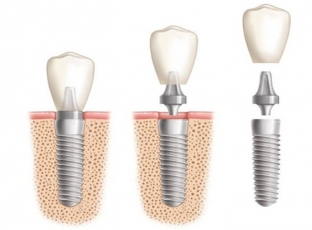Dentists say that today there is practically no middle-aged person who would have an absolutely complete dentition. In the elderly, the situation is much worse. In such patients, a certain number of teeth are completely missing, or the teeth are severely worn, which leads to their significant shortening. Such defects in the dentition are a serious cosmetic and aesthetic defect. In such cases, prosthetics are used, a variation of which is the establishment of a pin tooth. What is a pin tooth? What are its benefits?
What is a pin tooth? When is pin placement indicated?
The causes of complete or partial destruction of teeth are injuries, caries, genetic predisposition, poor nutrition and metabolic disorders. Modern dentistry has many ways and methods to restore the lost shape of teeth.
To restore a damaged tooth, a special pin is used. At the same time, the basal part of the tooth is preserved.
A pinned tooth means an installed fixed prosthesis, which consists of a pin, as well as an artificial crown region.
A pin is screwed into the preserved root of the damaged tooth and serves as a permanent reinforcement. Most often, the pin is used in the absence of a tooth crown and in case of root depulpation. For such pin prosthetics, there is a large arsenal of designs. Each design differs in material and manufacturing method.
Benefits of pinned tooth placement:
- the procedure is carried out in a short time;
- there is no need to wear large structures on your teeth;
- affordable cost;
- reliable fixation of the prosthesis;
- the only method that does not require the preparation of living healthy tissue.
Possibilities of prosthetics using pin teeth
Recently, dentists have been practicing the inlay method. To do this, stump tabs are placed on the saved healthy roots of the teeth. You can restore a missing tooth on the basis of these tabs by putting on a crown of the required material. The pin method of dental prosthetics is successfully used to restore the dentition of different groups of teeth.
Previously, pins were only placed on single-rooted teeth. Thanks to innovative methods in the field of prosthetics, the method can be used on all teeth, even in cases of tooth decay below the gum.
The pin method allows you to change the location of teeth that are outside the arch, or that protrude beyond the dentition. In this case, the teeth do not fully perform chewing functions, being a hindrance to neighboring teeth. Such situations require a thorough examination of the root of the tooth. It is important that it does not stagger and that it is deep enough.

Some dentists replace core inlays with anchor posts. Such structures are produced in combination with reinforced seals. If necessary, the tooth is covered with a crown of any material. Pin teeth serve up to 10 years without causing any discomfort to the patient either when chewing or when smiling.







Add a comment